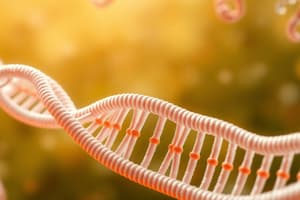Podcast
Questions and Answers
What is the primary function of Rho factor in prokaryotic transcription?
What is the primary function of Rho factor in prokaryotic transcription?
- To inhibit transcription elongation
- To promote transcription initiation
- To bind to a specific sequence in the RNA transcript, causing the polymerase to stall and release the RNA molecule (correct)
- To regulate mRNA processing
What is the primary function of polyadenylation in eukaryotic transcription?
What is the primary function of polyadenylation in eukaryotic transcription?
- To regulate transcription elongation
- To initiate transcription
- To stabilize the RNA molecule
- To terminate transcription (correct)
What is the purpose of capping in mRNA processing?
What is the purpose of capping in mRNA processing?
- To protect the 5' end of the RNA molecule from degradation (correct)
- To add a poly(A) tail to the RNA transcript
- To remove introns from the RNA transcript
- To promote transcription initiation
What is the role of transcription factors in transcription regulation?
What is the role of transcription factors in transcription regulation?
What is the primary function of splicing in mRNA processing?
What is the primary function of splicing in mRNA processing?
What is the final stage of transcription in both prokaryotes and eukaryotes?
What is the final stage of transcription in both prokaryotes and eukaryotes?
What is the role of initiation factors in transcription?
What is the role of initiation factors in transcription?
In which direction does RNA polymerase walk along the DNA template strand during elongation?
In which direction does RNA polymerase walk along the DNA template strand during elongation?
What is the function of cyclin-dependent kinases (CDKs) in transcription initiation?
What is the function of cyclin-dependent kinases (CDKs) in transcription initiation?
What is the base that replaces thymine in RNA transcription?
What is the base that replaces thymine in RNA transcription?
What is the role of the promoter in transcription?
What is the role of the promoter in transcription?
What is the direction of RNA synthesis during transcription?
What is the direction of RNA synthesis during transcription?
Flashcards are hidden until you start studying
Study Notes
Transcription is a crucial process in gene expression, involving the synthesis of RNA from DNA. The process is divided into three main stages: initiation, elongation, and termination. Each stage plays a vital role in generating a functional RNA molecule.
Initiation
Initiation is the first stage of transcription, where RNA polymerase recognizes and binds to the promoter of a gene. The promoter is a specific DNA sequence that serves as the starting point for transcription. Initiation factors, such as σ70 in bacteria and eukaryotic initiation factor TFIIB, help in the recognition and binding of RNA polymerase to the promoter. Cyclin-dependent kinases (CDKs), including CDK7 and CDK9, are involved in phosphorylating the C-terminal domain (CTD) of the largest Pol II subunit, which is necessary for transcription initiation.
Elongation
Once RNA polymerase is in position at the promoter, elongation can begin. Elongation involves the processive translocation of RNA polymerase along the gene body, adding individual nucleotides into the nascent RNA strand. RNA polymerase walks along the DNA template strand in the 3' to 5' direction, using one strand as a template to catalyze the synthesis of a new RNA strand in the 5' to 3' direction. The RNA transcript is nearly identical to the non-template or coding strand of DNA, but with the base uracil (U) in place of thymine (T) and a slightly different sugar in the nucleotide.
Termination
Termination is the final stage of transcription, where RNA polymerase stops transcribing and releases the RNA product for further processing. In prokaryotes, termination can occur via Rho-dependent or Rho-independent mechanisms. Rho-dependent termination relies on the binding of a protein called Rho factor to a specific sequence in the RNA transcript, causing the polymerase to stall and release the RNA molecule. Rho-independent termination depends on specific sequences in the DNA template strand, causing the RNA transcribed from this region to fold back on itself and form a stable hairpin, which stalls the polymerase and allows the enzyme to fall off, releasing the new RNA transcript.
In eukaryotes, termination occurs when a polyadenylation signal appears in the RNA transcript, marking the end of the RNA strand. An enzyme recognizes this signal and cuts the RNA transcript nearby, releasing it from RNA polymerase.
mRNA Processing
After transcription, the RNA transcript undergoes processing steps, including capping, splicing, and polyadenylation. These processes are essential for the proper function and stability of the RNA molecule.
Transcription Factors
Transcription factors are proteins that bind to specific DNA sequences and regulate the transcription process. They can either promote or inhibit transcription initiation and elongation. Structural studies of initiation and elongation complexes have allowed for the mapping of how these factors are exchanged during the early stages of RNA synthesis, leading to a better understanding of transcription regulation.
In summary, transcription is a complex process that involves several stages, including initiation, elongation, termination, and mRNA processing. These stages are regulated by various factors, including transcription factors, and are crucial for the generation of functional RNA molecules.
Studying That Suits You
Use AI to generate personalized quizzes and flashcards to suit your learning preferences.




